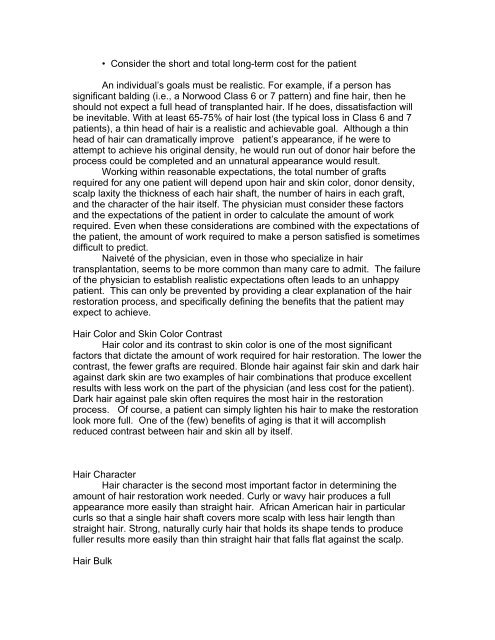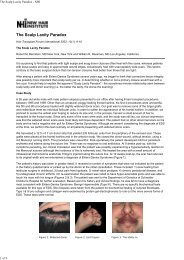The Patient's Guide to Hair Restoration - New Hair Institute
The Patient's Guide to Hair Restoration - New Hair Institute
The Patient's Guide to Hair Restoration - New Hair Institute
Create successful ePaper yourself
Turn your PDF publications into a flip-book with our unique Google optimized e-Paper software.
• Consider the short and <strong>to</strong>tal long-term cost for the patient<br />
An individual’s goals must be realistic. For example, if a person has<br />
significant balding (i.e., a Norwood Class 6 or 7 pattern) and fine hair, then he<br />
should not expect a full head of transplanted hair. If he does, dissatisfaction will<br />
be inevitable. With at least 65-75% of hair lost (the typical loss in Class 6 and 7<br />
patients), a thin head of hair is a realistic and achievable goal. Although a thin<br />
head of hair can dramatically improve patient’s appearance, if he were <strong>to</strong><br />
attempt <strong>to</strong> achieve his original density, he would run out of donor hair before the<br />
process could be completed and an unnatural appearance would result.<br />
Working within reasonable expectations, the <strong>to</strong>tal number of grafts<br />
required for any one patient will depend upon hair and skin color, donor density,<br />
scalp laxity the thickness of each hair shaft, the number of hairs in each graft,<br />
and the character of the hair itself. <strong>The</strong> physician must consider these fac<strong>to</strong>rs<br />
and the expectations of the patient in order <strong>to</strong> calculate the amount of work<br />
required. Even when these considerations are combined with the expectations of<br />
the patient, the amount of work required <strong>to</strong> make a person satisfied is sometimes<br />
difficult <strong>to</strong> predict.<br />
Naiveté of the physician, even in those who specialize in hair<br />
transplantation, seems <strong>to</strong> be more common than many care <strong>to</strong> admit. <strong>The</strong> failure<br />
of the physician <strong>to</strong> establish realistic expectations often leads <strong>to</strong> an unhappy<br />
patient. This can only be prevented by providing a clear explanation of the hair<br />
res<strong>to</strong>ration process, and specifically defining the benefits that the patient may<br />
expect <strong>to</strong> achieve.<br />
<strong>Hair</strong> Color and Skin Color Contrast<br />
<strong>Hair</strong> color and its contrast <strong>to</strong> skin color is one of the most significant<br />
fac<strong>to</strong>rs that dictate the amount of work required for hair res<strong>to</strong>ration. <strong>The</strong> lower the<br />
contrast, the fewer grafts are required. Blonde hair against fair skin and dark hair<br />
against dark skin are two examples of hair combinations that produce excellent<br />
results with less work on the part of the physician (and less cost for the patient).<br />
Dark hair against pale skin often requires the most hair in the res<strong>to</strong>ration<br />
process. Of course, a patient can simply lighten his hair <strong>to</strong> make the res<strong>to</strong>ration<br />
look more full. One of the (few) benefits of aging is that it will accomplish<br />
reduced contrast between hair and skin all by itself.<br />
<strong>Hair</strong> Character<br />
<strong>Hair</strong> character is the second most important fac<strong>to</strong>r in determining the<br />
amount of hair res<strong>to</strong>ration work needed. Curly or wavy hair produces a full<br />
appearance more easily than straight hair. African American hair in particular<br />
curls so that a single hair shaft covers more scalp with less hair length than<br />
straight hair. Strong, naturally curly hair that holds its shape tends <strong>to</strong> produce<br />
fuller results more easily than thin straight hair that falls flat against the scalp.<br />
<strong>Hair</strong> Bulk



